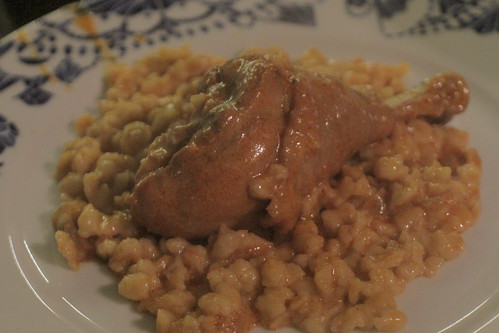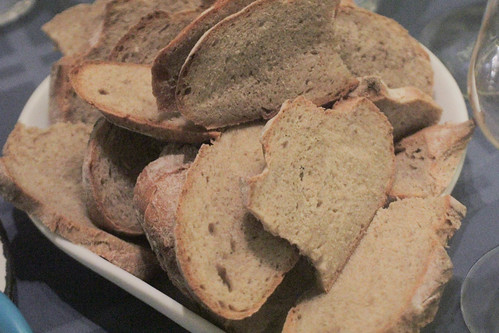Though it's common to think of Europe as being a jigsaw puzzle of peoples who've been there since before recorded history, the people who now populate the land known as Hungary didn't show up until a mere millennium ago. Known as the Magyars, they brought a herding tradition — and a non-Indo-European language most closely related to Finnish — from Siberia. Over the centuries, they settled into an intensely agricultural society that blended new foods such as paprika from the Turks and pastry from the Austrians into their meaty, brothy, bready core cuisine. (And oh, do they like their paprika: I used a quarter-pound in making this meal! If you're cooking Hungarian food, do yourself a favor and get some fresh stuff.) Related to jigsaws, one thing I've been mulling about after cooking this meal is that the old phrase, "The whole is greater than the sum of the parts," isn't always true. In fact, often you can get more utility out of breaking up an ingredient, and using each bit to its advantage. With the chicken, I was able to get several tablespoons of fat by trimming off the skin and slowly rendering it. (I used this in place of lard. No objection to lard, I'd just forgotten to buy some, and it was cold out!) And with the eggs in the torte, by separating the yolks from the whites, the recipe avails itself of the richness and emulsifying properties of the former, and the magical leavening properties of beating the former.

We were lucky to have two people of Hungarian descent, Michele and Danielle, with us. (I'm one-eighth Hungarian, for what it's worth!) Also on hand were Brandon, Diana, Irene, and Soo-Young who's in Budapest as I write this!
Gulyás | Beef and vegetable soup with paprika | Recipe

This dish, called "goulash" in English, was originally made by herdsmen, who'd slaughter one animal, make a huge stew in a hanging pot over a fire, and eat for several days. Accordingly, it's an unfussy dish, and while you'll see a whole lot of recipes out there, it's little more than cubes of meat slowly cooked in a broth scented with paprika and onions with some root vegetables thrown in toward the end. (The farmer's market happened to have parsley root; if you can't find that then parsnips are a good substitute.) I do particularly like this recipe for its caraway seeds, which add an almost minty aroma and play nicely off the brightness of the paprika.
Csirke paprikás | Chicken in paprika-sour cream sauce | Recipe

I loved this dish growing up. The vibrant color and flavor of the paprika, with the scrumptious creaminess of the sour cream, made for an unctuous sauce to smother over every bit of chicken and sop up with noodles. In my preparation, I took it two steps forward and one step back. The mistake was accidentally buying a hen instead of a chicken, which even after an hour and a half of braising was still pretty tough. The two things I did right: using super-thick, homemade sour cream, known as tejföl in Hungarian and known throughout Slavic countries as kajmak; and making spätzle-esque dumplings to sop up all that tasty sauce.
Nokedli | Little egg dumplings | Recipe
These dumplings are not at all complicated to make, it's just tedious them. Mixing up the dough takes all of two minutes, but scraping the dough back and forth across a spätzle plane over boiling water, and then scooping the little boiled dough bits, takes patience. They did go absolutely perfectly with the cream sauce, so I don't at all regret making them, and I'm happy I happened to have the proper device on hand. (If you don't have one, you can pinch off little bits of dough, but the texture wouldn't be the same and it'd be even more annoying to make!)
Kenyér | Crusty bread | Recipe

Just as no battle plan survives contact with the enemy, sometimes what I figure out to cook makes no sense once I start getting down to it. I'd identified a Hungarian bread recipe, but as I set out to start making it I realized it was of the sweet variety, nothing like the hearty, crusty bread that the above dishes require. So with several hours remaining until meal-time, I researched more deeply, only to discover that the best recipes require overnight fermentation. Drat! Well, I happened to find a website in Hungarian that through Google Translate seemed to approve of this no-knead recipe, with hints of rye and whole wheat, so I went for it.
I'd kind of looked down on no-knead breads — how would you develop the gluten? why are you afraid of touching the dough? — but you know what, for a fraction of the work and no additional time, this was one extremely decent loaf. The crust was decently thick and crunchy, the interior spongy and dense but not gummy. Really, an excellent bread for sopping up soup and sauce without falling apart. I think I'll make it again.
Uborka saláta | Cucumber salad | Recipe

As one description says, "Hungarian vegetables tend to be of the nongreen variety." Cucumbers make a notable exception, perhaps because of the crisp and cool contrast they make to the rich, soft stewed meats. This salad wasn't all that exciting, and I think I put too much water in the dressing so it was all just not very flavorful, and yet it took a lot of work to shave the cucumbers — since I don't have a mandoline, and I wanted thin uniform slices, I used a peeler instead.
Lecso | Stew of peppers, tomatoes and onions | Recipe

I probably didn't need to make this since there was so much other food going on, but it wasn't too hard. As another simmered dish, the texture matched that of the stews. The recipe mentions that it makes a good breakfast with some eggs on top, which sounds pretty similar to shakshuka, the North African dish.
Dobos torta | Chocolate-frosted layer cake | Recipe

I'm not huge on pâtisserie. The precise chemistry of baked goods is too much science and not enough art, while I'm a bit too haphazard to carefully handle and prepare fragile goods in precise preparations. But I had to game up for Hungary, which thanks to its split empire with Austria gained a strong expertise in making really tasty and impressively composed desserts. And all signs pointed to making this multi-layered cake, slathered with a thick coating of bar chocolate and butter to allow for long storage and transportation. (And flavor!)
The classic dobos torte is round, with a toffee crust. The cake part is little more than an really sweet omelet, with ten egg yolks, a pound of sugar, seven beaten egg whites, and less than a cup of sugar. Despite appearances, you don't cook one cake and then slice it like cheese, rather you bake the layers on their own. It's really tedious to bake each layer individually as would be required for a round cake, so I followed the Smitten Kitchen advice and simply made two jelly roll pans of cake and sliced them up. No good excuse on not having the toffee crust; I just messed that one up by being too cautious and removing the caramel from the stove before it was done, so I ruined one layer of cake and just junked it. But other than that, this cake was pretty easy, the frosting is especially forgiving and after refrigeration sets very nicely.
This was our last sit-down Nosh of the year. We've got a combined Honduras/Holy See holiday party coming up, and then in the new year we're onto the I countries!